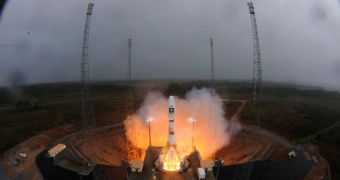Officials from the European Space Agency (ESA) have announced that the next two Galileo satellites will be launched on September 28, from the Kourou Spaceport, in French Guiana, South America. The spacecraft will be ferried to orbit aboard a Russian-built Soyuz delivery system.
Last year ESA finished constructing an entire Soyuz launch facility in South America, under a contract with the Russian Federal Space Agency (RosCosmos). The Europeans decided to go with the Russian medium-lift rockets for installing their Galileo satellite navigation system in Earth's orbit.
The constellation is being put together because the US Government does not provide its international partners with accurate data from its Global Positioning System (GPS), but rather reserves those data for its military. The Russians and the Chinese are building their own navigation systems as well.
The Vice President of the European Commission, Antonio Tajani, announced the new Galileo launches during a conference held in Brussels, on Wednesday, May 2. He said that ESA would respect its promise of launching the second pair of Galileo satellites within a year of the first two spacecraft.
Tajani made the announcement alongside the Chairman and CEO of Arianespace, Jean Yves Le Gall, and Didier Faivre, the ESA Director of the Galileo Program and Navigation-related Activities. Arianespace is the French aerospace company that builds the Ariane 5 heavy-lift rockets.
The very first pair of Galileo In-Orbit Validation (IOV) satellites were launched aboard a Soyuz rocket on October 21, 2011, and reached orbit successfully. They are now functioning within parameters.
“Four navigation satellites are the minimum needed for satellite navigation […] so these four Galileo satellites can be used to assess the performance of Galileo’s world-spanning ground system that serves to maintain the precision of the Galileo system,” an ESA press release explains.
At the same time, the IOV spacecraft will enable ESA contractors that worked on the ground receivers for this constellation to test their equipment with real satellite data, and then make the necessary adjustments, if any are required.
“Each satellite combines the best atomic clock ever flown for navigation – accurate to one second in three million years – with a powerful transmitter to broadcast precise navigation data worldwide,” the ESA statement adds.
When completed, Galileo will be significantly more precise than the aging American GPS system.

 14 DAY TRIAL //
14 DAY TRIAL //